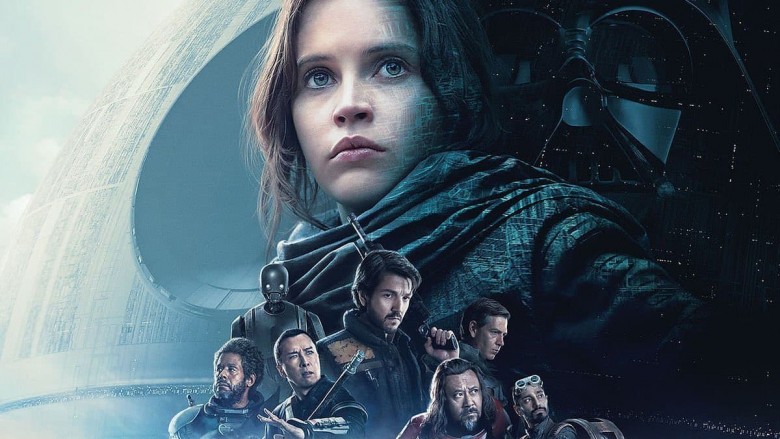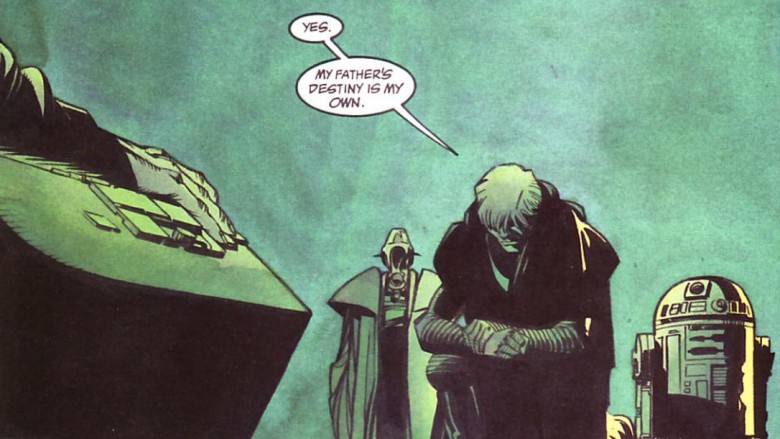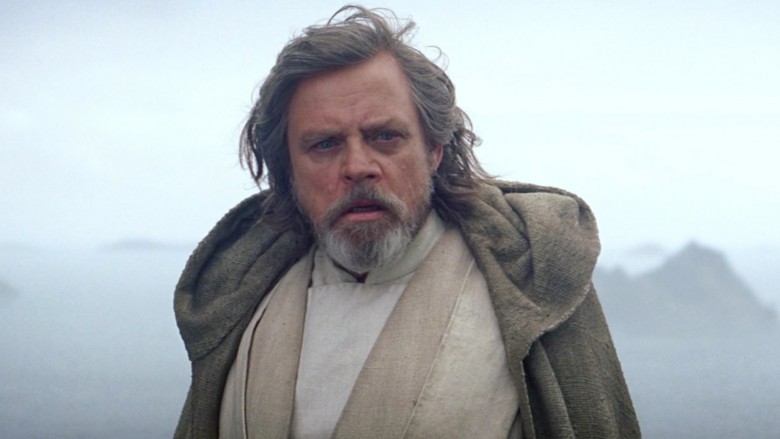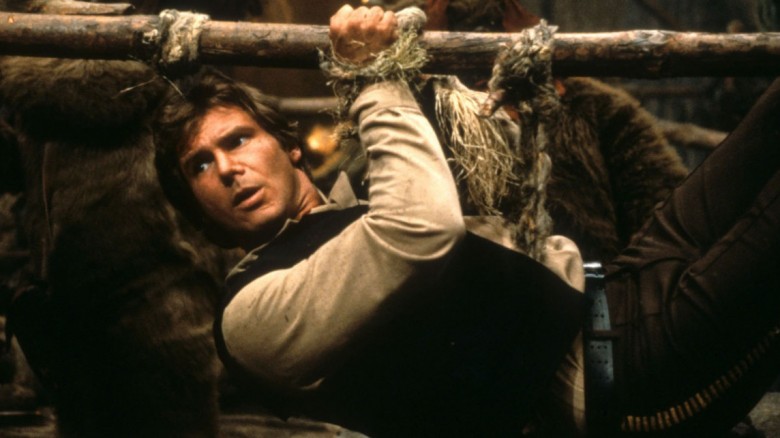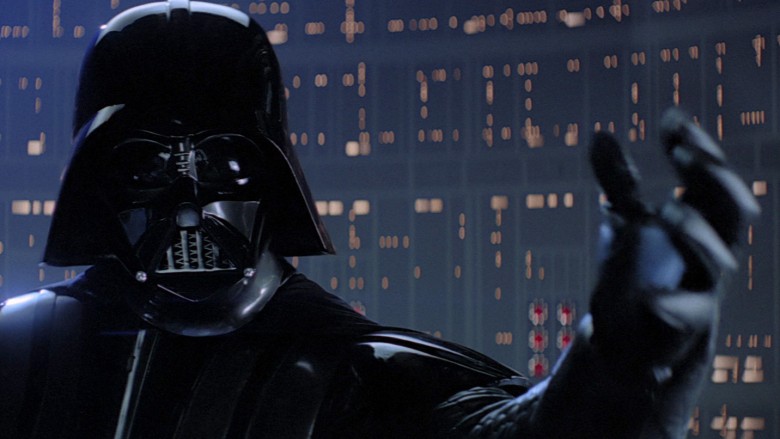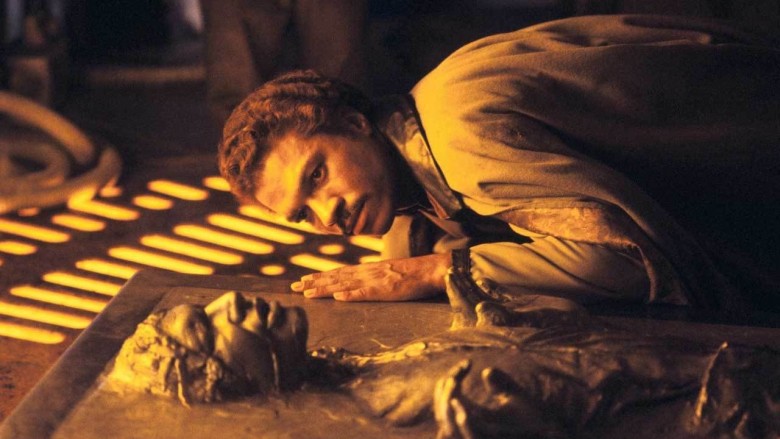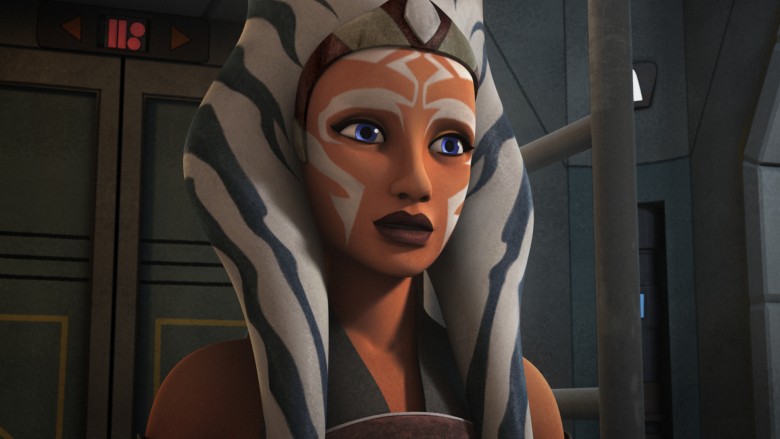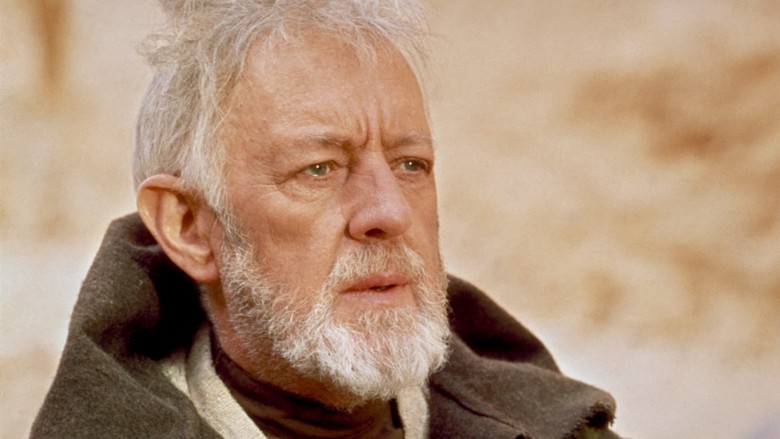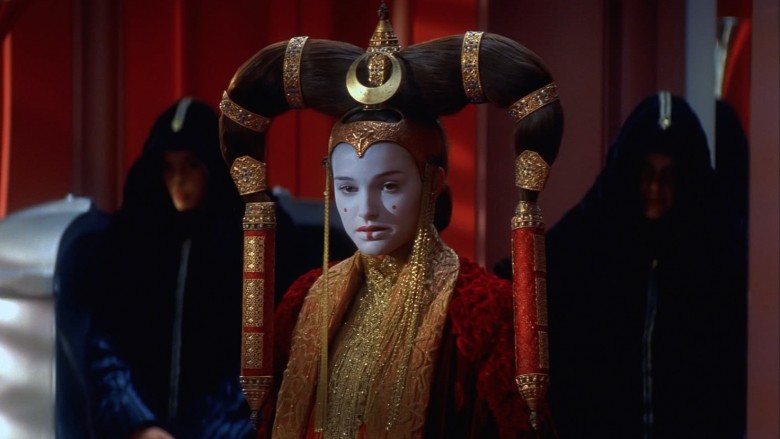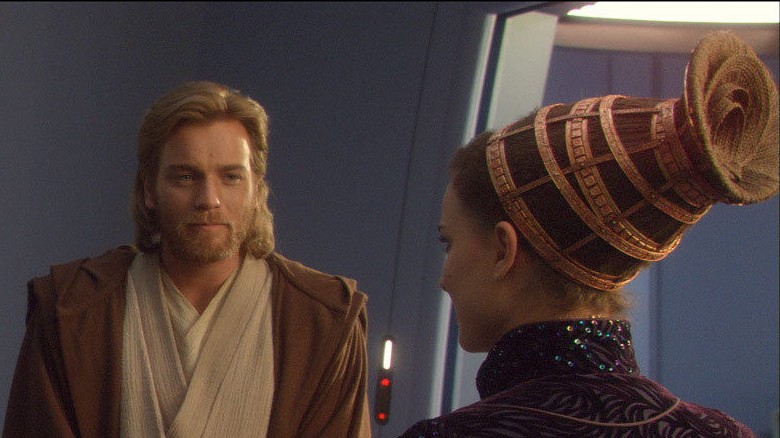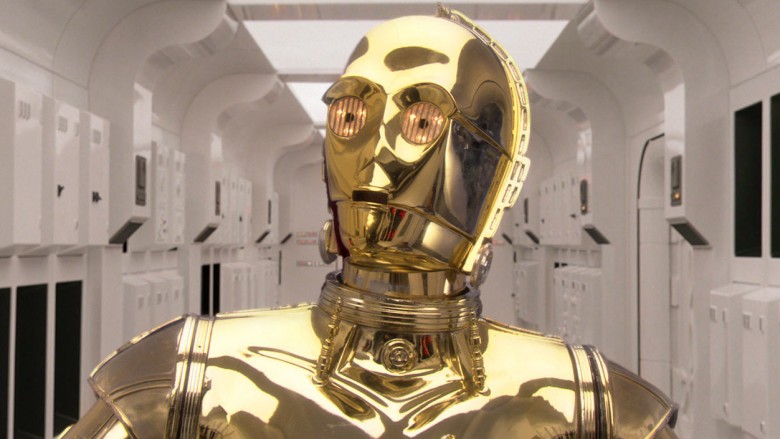Alternate Star Wars Endings
Generations of ardent Star Wars enthusiasts can repeat every line of every scene from every movie, word for word. But many fans don't realize that these films went through a lot of changes on their journey to the big screen—including some alternate endings that would have completely changed our favorite characters, their adventures, and the entire shape of the saga. You don't have to scavenge the internet like a Jawa to find these secrets—just check out this midichlorian-free guide to the wildest ways that Star Wars almost ended.
Rogue One's heroes live
Rogue One was a major hit for Disney, and it proved that Star Wars could spawn successful films that didn't revolve around the adventures of Luke Skywalker or Han Solo. However, fans of the movie quickly noticed that there was a lot of material from the early advertisements that never made it into the final movie, suggesting some major changes. In fact, parts of the film really were overhauled—including the ending.
The final cut of Rogue One ends on a heartrendingly bleak note, with all the major characters sacrificing their lives to deliver the Death Star plans to the Rebellion. The original ending, however, involved Jyn and Cassian escaping and living to fight (and presumably make out) another day. Other alternate endings included an even weirder final act in which everyone is frozen in carbonite by Cassian to save their lives.
Sadly, Rogue One Blu-Ray didn't let us see these scenes—meaning it joins the rest of the Star Wars saga in lettings its alternate endings be struck down, thus becoming more powerful in fans' imaginations than the creators could possibly imagine.
Luke becomes Vader
Ultimately, Luke Skywalker had a very bittersweet ending in Return of the Jedi. On one hand, he completed his ultimate trial by defeating Darth Vader and the Emperor. And Luke did it on his terms, too, without losing himself to the Dark Side as his father had. Luke even managed to have a happy reunion with his father after redeeming the man, something Obi-Wan and Yoda had thought impossible. At the same time, though, Luke lost his father almost immediately after he took the helmet off the dying man, which threatened to undermine all of his victories. This doesn't stop him from hanging around the Ewok campfire for the happy ending, but Return of the Jedi almost ended with Luke embracing pure evil.
In one of the original endings, things start going down in a very familiar way, with Vader still essentially sacrificing his life to help Luke defeat the Emperor, and Luke helping Vader take off his helmet. This, however, is where it gets weird—Luke was then going to put on Vader's mask and say "Now I am Vader." While this obviously did not happen, the fact that it was once the plan makes it a little less weird that people have speculated Luke could take some sort of villainous turn in Episode VIII or Episode IX.
Force Awakens almost had no Luke (and almost had too much)
Luke's appearance in The Force Awakens was an extremely crowd-pleasing moment. The entire movie had focused around finding the reclusive Jedi, after all, and he was the only character that could provide answers to Rey's (and the audience's) burning questions. The final shot of Rey offering Luke his lightsaber was the ultimate tease, leaving impatient audiences forced to wait two years to hear him speak. In different versions of Force Awakens scripts, however, they would have been waiting much longer to see Luke—or not waiting long at all.
According to producer Ben Rosenblatt, the final shot of the movie wasn't originally planned to show Luke. Instead, director J.J. Abrams allegedly wanted the movie to end with a close-up on Rey. And even earlier drafts of the movie had Rey meeting Luke "on the road" like she meets Han Solo. Co-writers Lawrence Kasdan and Michael Arndt eventually determined that Luke's presence overshadowed the new characters—a good point, but it's still fascinating to imagine what might have been.
Han Solo's death and the Rebellion's defeat
Han Solo's death is of the most heartbreaking scenes in Force Awakens. He's making an effort to redeem his Vader-adoring son Kylo Ren, just like Luke was eventually able to redeem Vader, but he fails—and is run through with a lightsaber before unceremoniously falling into one of those ever-present Star Wars pits. Han's death shocked and devastated fans in 2016...but it was originally supposed to happen in 1983.
Early drafts of Return of the Jedi had Han Solo dying while raiding an Imperial base. The idea was to basically subvert audience expectations, as Han would have been dramatically rescued at the beginning of the film and then suddenly killed later, after audiences thought he was safe. And, of course, if Han can die, it means anyone can, adding a lot of tension to the rest of the movie.
Star Wars creator George Lucas, however, overruled killing any main heroes. While many people already know Ford wanted Han to die in Jedi (he's been very public about it), most don't realize just how bleak those early scripts were: in addition to Han dying, the movie would have ended with the rebellion defeated, Leia becoming a queen, and Luke wandering off by himself. Basically, the early scripts for Return of the Jedi read like the writers were told it couldn't get more depressing than Empire Strikes Back, and said "here, hold my beer" (or maybe just "hold my blue milk").
Darth Vader wasn't Luke's father
Speaking of Empire Strikes Back, everyone knows about its stunning revelation that Darth Vader was secretly Luke's father, Anakin Skywalker. This was shocking for many reasons, but one of the biggest is that it rendered Obi-Wan Kenobi a liar—Obi-Wan, after all, told Luke that Vader betrayed and murdered Luke's father in the first movie. In Return of the Jedi, Obi-Wan would offer a weak defense by telling Luke it was "true...from a certain point of view." However, Obi-Wan in A New Hope was telling the only truth he knew, as Vader wasn't originally supposed to be Luke's father.
This is one of many stark differences found in the early Empire Strikes Back script written by Leigh Brackett. After Brackett succumbed to cancer in 1978, Lucas and Lawrence Kasdan made some pretty dramatic changes, moving away from the draft in which Luke actually sees Anakin Skywalker's Force ghost when he's on Dagobah (charmingly known in this script as "the bog planet"), so when he does confront Vader later, there's no dramatic revelation of paternity. While there's no denying the power of the "I am your father" reveal, it's interesting to imagine a Star Wars universe in which Vader is an entirely different character who potentially has entirely different motivations for his servitude to the evil Emperor.
Han wasn't frozen in carbonite
Speaking of that early Empire Strikes Back script, one of the notable differences from the final movie is that Han wasn't supposed to be frozen in carbonite. A lot of the final bits of the movie are still in place in this early draft, such as Han being betrayed by Lando in a city in the clouds and the heroes eventually escaping into space. In the final movie, of course, they were leaving on a mission to rescue Han from Jabba the Hutt. What were they supposed to be doing originally? Han and Chewie were actually going off to meet a man named Ovan Marekal—Han's stepfather and the leader of an influential transport guild that Han hopes to lure into the Rebellion.
One reason for the change is that over the years, Harrison Ford had expressed some serious doubts as to whether he would be willing to return for the final movie in the trilogy—unlike his younger co-stars, he hadn't signed a three-film deal. Lucas and Kasdan froze the character in carbonite, a process could possibly kill him, to give them a number of different narrative options for explaining Han's eventual death if Ford didn't return.
Ahsoka: hero of the Clone Wars
Clone Wars might have seemed at first like a cheap Star Wars cash grab, but this beloved animated series ended up telling complex stories set during the prequels—that were often much better than the prequels themselves. The show was cut off before it could complete its intended arc, which meant the final episode was a bit disconnected.
During that episode, Yoda travels to the Sith homeworld on a quest to figure out how to live on after death, Force ghost style. It's neat for understanding Force mythology and Yoda himself, but it doesn't really illuminate much about favorite characters like Obi-Wan, Anakin, and Anakin's apprentice, Ahsoka Tahno. In fact, we last see her when she's kicked out of the Jedi order for a crime she didn't commit. Anakin uncovers the true culprit and a contrite council invites Ahsoka back, but she declines...and is never seen again until she pops up in the Rebels television show. Originally, however, she was supposed to factor very prominently in the end of Clone Wars.
If the show had gone on longer, the creators imagined an interesting arc for Ahsoka that involved the character surviving in Coruscant's grimy underbelly, falling in love with a scoundrel, and even returning to the Jedi (but as an advisor rather than a Jedi knight). Eventually, she was supposed to go with Obi-Wan, Anakin, and a bunch of clone troopers to fight Darth Maul on the planet Mandalore. When they get there, Obi-Wan and Anakin are called back to Coruscant to go rescue Palpatine—which we see at the beginning of Revenge of the Sith—leaving Ahsoka to lead the clone army. We later see her in a forest clearing after Order 66 has been issued, and as the clones close in to try to kill her, forest wolves (possibly summoned by Ahsoka) close in around them and end up killing all the clones before they can destroy the former Jedi. This would have been amazing to see—and served as a clearer setup into Ahsoka's transition to the confident badass audiences see in Star Wars: Rebels.
Obi-Wan survived
The death of Obi-Wan Kenobi is a central element in the original Star Wars trilogy—a moment representing a character sacrificing himself for the survival of a greater good. And, as Obi-Wan warned Vader, the Jedi master would become "more powerful than" Vader "could possibly imagine," as he could now advise Luke wherever he went, including the Death Star trench. Thematically, Obi-Wan's death made sense on every level: the death of his mentor forced Luke to grow as a warrior and a Jedi, and Obi-Wan's triumph through sacrifice rather than combat helped to really highlight the differences between the Light Side and the Dark Side. All of which makes it that much more surprising that Obi-Wan wasn't originally supposed to die.
Peter Mayhew, the beloved actor who portrayed Chewbacca, dropped a bombshell via Twitter when he revealed pictures from the original Star Wars: A New Hope script showing that Obi-Wan was supposed to survive the conflict. Remember how Luke lowered the blast door by shooting the panel, keeping Darth Vader away long enough to escape the ship? Obi-Wan would have been the one to lower that door, allowing the team to escape together. This change would have had profound effects on the rest of the Star Wars mythology.
Padme saves everyone
Star Wars: The Phantom Menace rather infamously tried to recreate the old Star Wars charm with a climax that involved a bunch of smaller starfighters teaming up to take down a space station-sized Trade Federation ship. Of course, the actual action was disappointing, both because of the forgettable CGI as well as the script calling for Jake Lloyd's Anakin to accomplish everything of significance by accident, making death-defying dodges because he suddenly thinks spinning would be a "cool trick" and blowing the station up from the inside by hitting random buttons inside his starfighter. It was terrible, but it was almost improved by one unexpected element: Natalie Portman's Queen Amidala.
In an early script for Phantom Menace, the starfighter that Anakin uses is actually a two-seater, and Padme flies with him as the gunner. Instead of everything happening as a weird comedy of errors, Padme serves as a badass commander, ordering other pilots to make pivotal attacks against weak points so they can make a final strike. Ultimately, she would have been the one to fire the pivotal shot that destroys the Trade Federation ship and effectively wins the battle.
Of all of the opportunities missed by changed Star Wars endings, this is really one of the saddest. Having Padme as a gunner not only would have fixed the misguided attempts at humor and happenstance that hindered this sequence, but it would have given her more to do. Despite being the ruler of the planet, Amidala spends half of the movie being rescued or helped by other characters, and the other half being forced to do weird, menial tasks by one of her handmaidens posing as the Queen.
Padme's hot for teacher
Over the years, the Star Wars prequels have been the subject of much fan scrutiny, including arguments that the movies are actually genius because of some hidden aspect, as presented in the Ring Theory. Other times, though, the scrutiny comes from wistful fans thinking of how a few simple changes could have made the prequels better. This is the case with an Uproxx article that gets into an in-depth speculation about how an Anakin, Amidala, and Obi-Wan love triangle would have made the prequels and their conclusion much more satisfying—and surprisingly, that triangle nearly made its way into the movies.
According to George Lucas biographer Dale Pollack, early scripts for Revenge of the Sith included a plot regarding a "torrid love triangle" between the three characters. Not only that, but finding out that Obi-Wan had betrayed him in such a way was supposed to be the final thing that drove Anakin Skywalker to the Dark Side. Obviously, ghosts of this plot still linger in the final movie, such as Anakin's jealousy-tinged response to Amidala saying she can't go down this dark path with him: "is it because of Obi-Wan?"
This ending would have fit better into the entire Star Wars mythology—it provides a true motivation for Anakin's corruption, and it adds drama to the final fight between Anakin and Obi-Wan, making it about love instead of philosophical principle. It even would have even added a weird wrinkle to Palpatine's observation in Return of the Jedi that Luke's new lightsaber was much like his father's—visually, Luke's green lightsaber hilt looks a lot more like Obi-Wan's than it does Anakin's old lightsaber or Vader's new one.
C-3PO blows up the Death Star
The destruction of the Death Star in Star Wars: A New Hope was presented as a kind of miracle. Several pilots gave their lives during the assault, and anyone other than Luke (with his assistance via the Force from Obi-Wan Kenobi) would have been unable to make the perfect proton torpedo shot. And Luke would have been dead in space if Han Solo hadn't shown up in the nick of time. In early drafts of the script, however, it wasn't nearly as hard to destroy the Death Star—in fact, C-3PO was the one who did it.
Early on, the Death Star itself was conceived differently. Rather than being a purely "technological terror," it instead channeled the dark energy of "Bogan," which was basically an early version of the Dark Side of the Force. Some of the broad elements of the final movie were still in this early script, such as Vader destroying the other Rebellion pilots and Han and Chewbacca's last-minute arrival saving Luke's life. Here's where it gets weird, though: Vader was supposed to careen into Han's ship, forcing Han and Chewbacca to eject and leaving it to C-3PO, who'd been riding shotgun, to make the fateful shot that destroys the Death Star. We'll never see this on the big screen, but it's fun to imagine a galaxy far, far away in which countless lives were saved by a prissy golden droid who hates space travel.

